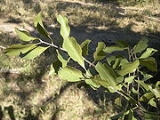
Capparis mitchellii
Encyclopedia
The "Wild Orange" is an Australian native plant. Its scientific name is Capparis mitchellii; it is not related to orange
s and neither to the Osage-orange
which is known as "wild orange" in North America
, but to caper
s. Its name in the Arrernte language of Central Australia
is merne atwakeye.
Wild oranges are a tasty bush tucker food. Indigenous Australians made frequent use of it long before European arrival. It is green when unripe. When it ripens, it becomes soft and has a fragrant smell. The inside is yellow or orange. It is still commonly eaten in the desert today.
Orange (fruit)
An orange—specifically, the sweet orange—is the citrus Citrus × sinensis and its fruit. It is the most commonly grown tree fruit in the world....
s and neither to the Osage-orange
Osage-orange
Maclura pomifera, commonly called Osage-orange, hedge-apple, Horse-apple, Bois D'Arc, or Bodark, is a small deciduous tree or large shrub, typically growing to tall. It is dioeceous, with male and female flowers on different plants...
which is known as "wild orange" in North America
North America
North America is a continent wholly within the Northern Hemisphere and almost wholly within the Western Hemisphere. It is also considered a northern subcontinent of the Americas...
, but to caper
Caper
Capparis spinosa, the caper bush, is a perennial winter-deciduous species that bears rounded, fleshy leaves and large white to pinkish-white flowers. A caper is also the pickled bud of this plant...
s. Its name in the Arrernte language of Central Australia
Central Australia
Central Australia/Alice Springs Region is one of the five regions in the Northern Territory. The term Central Australia is used to describe an area centred on Alice Springs in Australia. It is sometimes referred to as Centralia; likewise the people of the area are sometimes called Centralians...
is merne atwakeye.
Wild oranges are a tasty bush tucker food. Indigenous Australians made frequent use of it long before European arrival. It is green when unripe. When it ripens, it becomes soft and has a fragrant smell. The inside is yellow or orange. It is still commonly eaten in the desert today.

